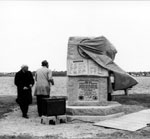
ON THE MIRAMICHI: The monument erected by the Miramichi and District Labour Council is situated at River Front Park (Ledden Street) on the north shore of the Miramichi River. Note the symbolism of the open honour roll and the caged canary, and the importance of the inscription: “Fight for the Living! Mourn for the Dead” .
The dangers of the workplace are well-known to the people of the Miramichi. The history of the lumber camps, mill towns and other workplaces of the region is marked by the memory of hundreds of lives lost at work and thousands of injuries sustained in the course of employment.
One tragic early accident was the death of a Prince Edward Island youth who died following an accident yarding logs in the woods in the winter of 1880-81. The story of his death is remembered in “The Ballad of Peter Emberley” , one of the classic folk songs of the North American lumber woods. In 1963 a black granite stone was placed over Emberley's grave at St. Joachim's Cemetery at Boiestown, a personal memorial to one worker and also an example of the tradition of remembering those who lost their lives at work.
In 1995 the people of the Miramichi dedicated a monument to all workers who have been killed or injured on the job. This monument is located in River Front Park (Ledden Street) near the public library in Newcastle. Situated on the river, it is a reminder of the many thousands of workers and families whose lives have been shaped by the economy and resources of the Miramichi River.

CONSTRUCTION: Lowering the Miramichi monument into place at the site.
Plans for the monument started in January 1994 when members of the Miramichi and District Labour Council discussed ways to mark the Day of Mourning originated by the Canadian Labour Congress ten years earlier. The organizing committee was chaired by Ed Coleman, a member of the Communications Energy and Paperworkers Union, Local 689, who worked at the REPAP mill in Newcastle and was an active member of the Health and Safety Committee of the New Brunswick Federation of Labour. It was agreed that the committee would seek to have the monument produced by New Brunswick workers using New Brunswick stone.
In its final form the monument features the image of a canary – a widely recognized symbol of the early warnings used by miners to identify the build-up of dangerous gases underground. If the canary died, it was time for workers to leave work because conditions were not safe. In a press release in 1995, the labour council underlined this theme: “The goal of this monument is to remind people that so many people are needlessly giving up their lives. We must never allow ourselves to return to the time when we have to use canaries to alert us to any possible dangers that are around us” .
There was a solemn ceremony at the site of the monument on the Day of Mourning on 28 April 1995, which opened with a dedication by Father Bernard Broderick of Miramichi East. The monument was formally unveiled by veteran local union leaders Ed Quinn and Tim McCarthy. New Brunswick Federation of Labour President John McEwen, whose own father was the victim of a workplace fatality many years earlier, spoke of the need for stronger health and safety legislation in the province. Other speakers included Member of Parliament Charles Hubbard and New Brunswick New Democratic Party leader Elizabeth Weir. Miramichi Mayor Janice Morrison acknowledged the work of the labour council in establishing the memorial, and there were closing prayers from the Reverend R. E. Feltmate.

MONUMENT UNVEILED: The monument was unveiled on 28 April 1995 by veteran local union leaders Tim McCarthy (left) and Ed Quinn (centre left).
The unveiling was followed the next day by a banquet at the Royal Canadian Legion Branch 10, where Canadian Labour Congress secretary-treasurer Dick Martin was the featured speaker. A mineworker from Thompson, Manitoba, Martin had played a large part in putting health and safety issues back on the agenda of Canadian unions in the 1970s and 1980s. According to Tim McCarthy, a former president of the New Brunswick Federation of Labour, Martin reminded his audience of the high cost of workplace accidents in Canada – hundreds of lives lost every year, thousands of injuries and billions of dollars in costs: “He reminded those present that we must not forget those who lost their lives while just trying to provide a decent living for themselves and their families” .
The people of the Miramichi do not forget. In his recent novel The Friends of Meager Fortune (2006), David Adams Richards writes about a monument to workers high in the hills around Good Friday Mountain. It is not certain if that monument ever existed or if it was purely imaginary, but there is truth in the fact that the people of the Miramichi have not forgotten those who have lost their lives at work.
Down at the River Front Park, the Day of Mourning continues to be observed annually on 28 April in front of a monument that bears an open honour roll. At the top of the monument there is an important inscription, adapted from the words of a famous early union organizer known as Mother Jones: “Fight for the Living! Mourn for the Dead” .